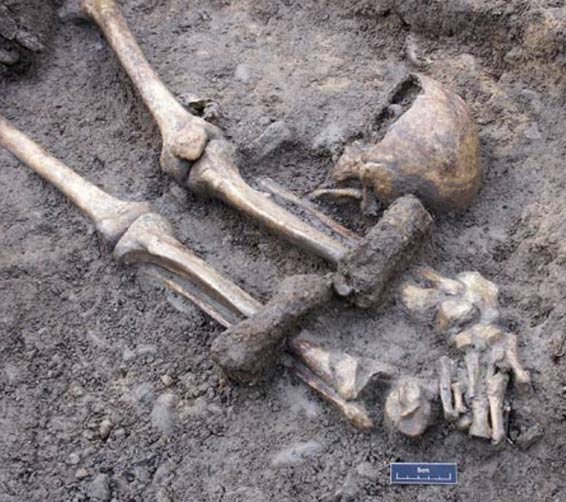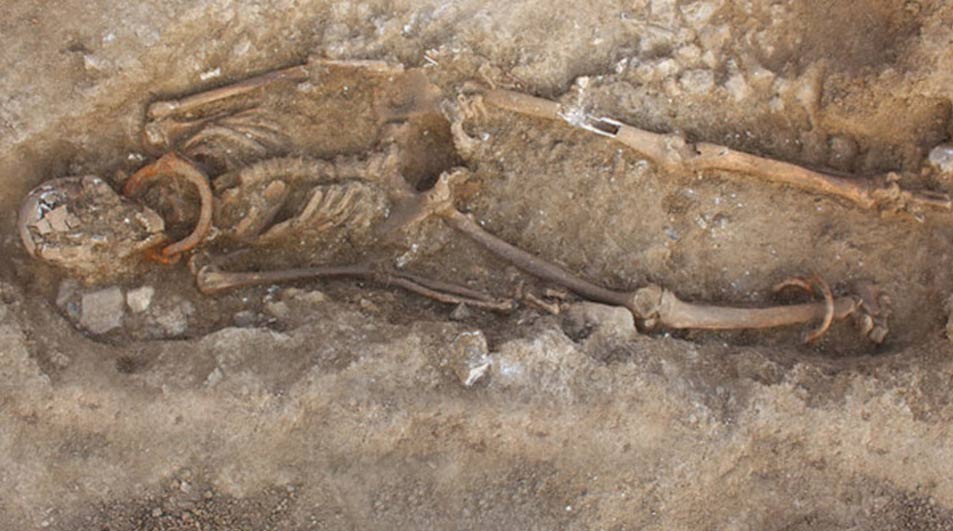Shackled adult and child skeletons unearthed in ancient Roman necropolis in France
An archaeological team in France has unearthed a Gallo-Roman necropolis in Saintes, France, in which the remains of a group of adults and a child were found with iron shackles around their wrists, ankles, and/or necks. Archaeologists are trying to unravel the story of these individuals’ lives, their origin, and the circumstances of their death.
The excavation of the necropolis, located approximately 250m to the west of the amphitheatre of Saintes, was led by the Institut national de recherches archeologiques preventives (INRAP), and was prompted by the need to locate an area for a new burial ground. Saintes was a regional capital during the period of Roman rule in France, and is famous for its Roman colosseum-style arena, which once held up to 18,000 people.

The Roman arena in Saintes, France. Credit: Maxence Lagalle / flickr
During the dig, which began last year, they discovered hundreds of graves dating back to the 1 st and 2 nd centuries AD. Many of the graves were double burials, containing individuals buried head to tail in rectangular pits, although one grave was found containing five individuals. Strangely, no grave goods were found in any of the burials, except for one grave belonging to a young child, which was buried with seven vases and two coins over his/her eyes. This was a Roman custom related to the belief that a person’s spirit would leave their body at death and must pay coins to a ferryman that would take them across a river that divided the world of the living and that of the dead.
However, the most surprising discovery was made during the dig between September and November this year, in which archaeologists unearthed four adults and one child with hot riveted iron shackles still attached to either their wrists, ankles and/or necks. Some of the adults were found with multiple shackles and neck ‘bondage collars’, while the child was found with a shackle attached to the left wrist.

Skeleton with Iron bondage collar around the neck. Credit: Frédéric Méténier, Inrap 2014
It is not the first time that ancient remains have been found in shackles. In 2005, archaeologists discovered human remains in York, England, also dating back to the period of Roman occupation. At least one of the skeletons was found with iron shackles still attached to the ankles, alongside his decapitated head. Researchers at the time proposed that the individuals were slaves, criminals, or gladiators. The latter theory is supported by the fact that some of the bones were found with bite marks, suggesting they may have been killed by animals in the gladiator arena.

2nd century AD skeleton with misplaced skull and heavy lead leg-shackles found in York, England. Credit: York Archaeological Trust
Further research will be carried out on the skeletons in Saintes to determine the status of these individuals, their origin and causes of death, as well as how they might relate to the other people buried within this graveyard.
Featured image: This male was shackled around the neck and right ankle. Credit: Frédéric Méténier, Inrap 2014




















Comments
From the article, "Roman custom related to the belief that a person’s spirit would leave their body at death and must pay coins to a ferryman that would take them across a river that divided the world of the living and that of the dead." Would people believe this today? People don’t change. Was it REALLY true?
And a couple things don’t add up with the photo – https://www.ancient-origins.net/sites/default/files/field/image/skeletons-roman-necropolis-france.jpg 1) Why would there be a shackle on the leg, if there were a shackle on the neck? The neck alone would be enough. 2) The shackle on the leg is too big. A foot could go through it.
Nobody gets paid to tell the truth.
How sad a life they led, if I had found them I would be so tempted to remove the shackles at long last.